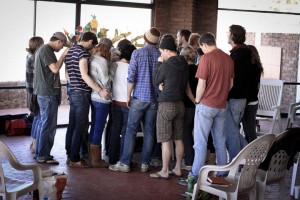In part 1 I discussed the early developments of monasticism that later gave birth to a missional movement that was beautifully embodied in St. Patrick (Part 2). Today we ask the question, how do we live out the best of both of these movements and daily live life as monastics on mission in our neighborhoods?
Where the image of monasticism has historically been that of a culturally removed monastery and the image of “missions” movements have at times been  fueled less by the Spirit and more by blind ambition, members of NieuCommunities seek to hold both images in tension and pave a new road forward. Such a road is to be characterized by what we see is the best of both movements and their valuable contributions to the missio dei. In the context of neighborhood, we seek to sustain and multiply missional-monastic communities that form apprentices of Jesus through contemplative life in the context of intentional community. At the same time, we seek to develop missional leaders who see all aspects of life as potential birthing places for the extension of the kingdom.
fueled less by the Spirit and more by blind ambition, members of NieuCommunities seek to hold both images in tension and pave a new road forward. Such a road is to be characterized by what we see is the best of both movements and their valuable contributions to the missio dei. In the context of neighborhood, we seek to sustain and multiply missional-monastic communities that form apprentices of Jesus through contemplative life in the context of intentional community. At the same time, we seek to develop missional leaders who see all aspects of life as potential birthing places for the extension of the kingdom.
In the same way that our God moved into the neighborhood, seeking to invite us into his story of reconciliation, God’s people have been commissioned to missionally engage our neighborhoods with the good news of the kingdom—a kingdom whose king was enthroned through selfless sacrifice and suffering
Put simply, we believe missional-monastic community creates a fertile soil to commune with God, live in deep community with others, and extend the good news of the kingdom in our local contexts. We believe this because we have experienced the richness of this way of life and ministry for ten years, but also because Jesus offered an integrated example of deep community (both with God and others) and mission.
In the Gospel accounts of Jesus’s life and ministry, there are three values of paramount importance to communities of people seeking to faithfully participate in the missio dei. First, Jesus walked with God. He communed with his father regularly and sought to live out the story God thought best for him. While others caught up on their sleep, Mark lets us know that Jesus always found a way to get time in with the Father: “Very early in the morning, while it was still dark, Jesus got up, left the house and went off to a solitary place, where he prayed” (Mark 1:35). The life and ministry of Jesus were first fueled by his intimate connection with his Father. We call this value communion.
Second, Jesus invited others to share in this story. It was not a story or mission that he thought best to embark upon alone. In fact, the very nature of the mission was that of community. God was seeking to restore community with the cosmos, and Jesus’s invitation to companions for the journey gives us deeper glimpses into life in the kingdom. It is not a passive form of community, but an extremely intentional form that requires each to give up everything for the sake of others and the mission. When Jesus said, “‘Come, follow me’” (Mark 1:17), he wasn’t simply inviting people to come to an event. He was inviting them to come and live with him and change the way they live. We call this value community.
Finally, Jesus’s life and ministry make it clear that the mission is not to be extended only through his life. It is a mission that requires others to advance to the ends of the earth in the generations to come. This reality is made clear in his acts of equipping his disciples through sharing life and sending them as kingdom representatives into their unique contexts. Jesus commissions them to dive deep into their contexts as a sent people fueled by their communion with God and sustained by their commitment to one another in community. Jesus sends us to enflesh good news in our neighborhoods just as he was sent to do: “‘As the Father has sent me, I am sending you’” (John 20:21). We call this value context.
In the first chapter of Mark’s Gospel, all of these values jump out of the story and are deepened and extended in the chapters that follow. While the monastic and missional movements are helpful in framing our place in church history, it is ultimately in the life of Jesus and his commitment to communion, community, and context that we find our framing example of life and ministry. With this model, we daily make our attempt to walk faithfully with Jesus and equip others to do the same in the unique soil of their context.
Through our commitment to engage God in communion, to engage one another in community, and to engage our contexts as the people of God, we have found a way (although very much a work in progress!) to integrate these often conflicting movements—monastic and missional—in a holistic, life-giving way of life.
The majority of this post is an excerpt from my book (with Rob Yackley) Thin Places: Six Postures for Creating and Practicing Missional Community, published by The House Studio

Jon,
Thanks for sharing this. You put into words what many of us know to be true. Your historical review brings a smile to my face as it reminds me of how God’s Spirit keeps us on track concerning mission and formation. Thanks too to all the members of NieuCommunities.
Thanks, Vicky! We certainly aren’t doing anything new, but honored to be part of this beautiful, Spirit-driven tradition.
Great stuff Jon!